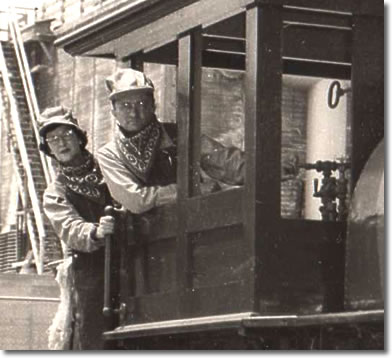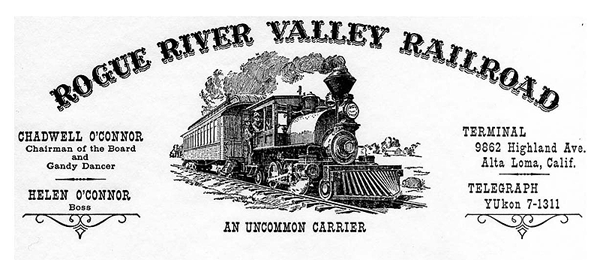An Early Member of the Southern California Live Steamers, Chadwell O’Conner
Chadwell O’Conner (1915-2007) is best known by railroad enthusiasts as the builder of the full size operating replicas of the Golden Spike locomotives. His O’Conner Engineering Laboratories of Costa Mesa was awarded a 1.5 million dollar federal grant in 1975, to recreate the two steamers to operate in conjunction with Utah’s new museum at Promontory where the original completion of the First Transcontinental Railroad took place in 1869. Four years later the engines met head to head at the 110th anniversary celebration, on a new section of track built on the exact spot where the Golden Spike was driven more than a century earlier.
This was not Chad’s first experience with full size locomotives. In 1952, he bought a small standard gauge 0-4-0T saddle tank loco that last operated for the 24 mile long Lorane Valley Lumber Company in Cottage Grove, Oregon. two years earlier, Chad became a member of the Southern California Live Steamers. He was a serious rail fan who loved to take movies of the local railroads.
A mechanical engineer by profession and employed as a design engineer for the City of Pasadena, he was shooting 16mm movies of passing trains at Glendale station, when a man took notice of how smoothly his tripod head worked, and wondered where he had gotten it from, as he was a film maker and was having problems with telephoto shots looking jerky as the camera was panned. Chad was unaware that he was talking to fellow Southern California Live Steamers club member Walt Disney. Walt talked Chad into building one to handle the heavier 35mm cameras, and that was the start of his patented O’Connor fluid pan and tilt camera head.
By the late 1950’s Chad was producing four models, one which could handle up to a 200 pound camera, and one that was developed for the aerospace industry for tracking missiles. Chad had moved to Alta Loma by this point in time, and had gotten permission to operate his now rebuilt saddle tank locomotive on a mile of abandoned Santa Fe Track. His little ten ton engine was built by H. K. Porter of Pittsburgh, Pennsylvania in 1891, and was construction number 1236. She first ran for the Rogue River Valley Railroad in Medford, Oregon in passenger service, and had many subsequent owners, ending her career in Cottage Grove, Oregon in 1951. Originally built as a 2-4-2T, she eventually had her pilot and trailing trucks removed. In 1960, Chad commissioned me to create artwork for new stationery for his railroad from a photograph of Chad in the cab and Helen, his wife, standing on the deck.

Chad and his wife Helen in his restored Porter Number 1, on their Rogue River Valley Railroad taken in Alta Loma, California in the late 1950’s. Photograph is from the Chad O’Connor collection.

He wanted my pen and ink drawing to include a future passenger car, as well as adding the missing pilot and trailing truck wheels which he wanted to someday replace. The main curved lettering was hand drawn, as was the fancy line work. The small letters were cut out and individually pasted up. Featured is Harlan Hiney’s artwork for Chad’s personal stationery.

A lot of work in those early days before computer generated artwork. During the same period Chad had me create artwork for a uniform format for his nameplates that went on his fluid camera heads. Each of the four models had its own individual design and he wanted them all to look the same. I had no idea at that time how famous his tripod heads would become, but after the first one made for Walt Disney, they became one of the best in the movie industry. In 1976, he received an Oscar for his contribution to the film industry and in 1994 a technical achievement award by the Society of Operating Cameramen
|




